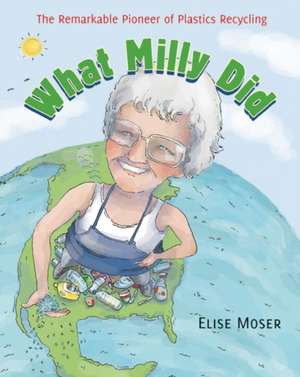What Milly Did: The Remarkable Pioneer of Plastics Recycling
Autor Elise Moser Ilustrat de Scot Ritchieen Limba Engleză Paperback – 9 aug 2016 – vârsta de la 8 până la 11 ani
The extraordinary story of the woman who made plastics recycling possible.
Milly Zantow wanted to solve the problem of her town's full landfill and ended up creating a global recycling standard - the system of numbers you see inside the little triangle on plastics. This is the inspiring story of how she mobilized her community, creating sweeping change to help the environment.
On a trip to Japan in 1978, Milly noticed that people were putting little bundles out on the street each morning. They were recycling - something that hadn't taken hold in North America. When she returned to Sauk City, Wisconsin, she discovered that her town's landfill was nearing capacity, and that plastic made up a large part of the garbage. No one was recycling plastics.
Milly decided to figure out how. She discovered that there are more than seven kinds of plastic, and they can't be combined for recycling, so she learned how to use various tests to identify them. Then she found a company willing to use recycled plastic, but the plastic would have to be ground up first.
Milly and her friend bought a huge industrial grinder and established E-Z Recycling. They worked with local school children and their community, and they helped other communities start their own recycling programs. But Milly knew that the large-scale recycling of plastics would never work unless people could easily identify the seven types. She came up with the idea of placing an identifying number in the little recycling triangle, which has become the international standard.
Milly's story is a glimpse into the early days of the recycling movement and shows how, thanks to her determination, hard work and community-building, huge changes took place, spreading rapidly across North America.
Correlates to the Common Core State Standards in English Language Arts:
CCSS.ELA-LITERACY.RI.3.3
Describe the relationship between a series of historical events, scientific ideas or concepts, or steps in technical procedures in a text, using language that pertains to time, sequence, and cause/effect.
CCSS.ELA-LITERACY.RI.4.7
Interpret information presented visually, orally, or quantitatively (e.g., in charts, graphs, diagrams, time lines, animations, or interactive elements on Web pages) and explain how the information contributes to an understanding of the text in which it appears.
Preț: 40.50 lei
Preț vechi: 53.20 lei
-24% Nou
7.75€ • 8.45$ • 6.53£
Carte indisponibilă temporar
Specificații
ISBN-10: 1554988934
Pagini: 44
Ilustrații: 20 B&W illustrations
Dimensiuni: 171 x 216 x 3 mm
Greutate: 0.07 kg
Editura: GROUNDWOOD BOOKS
Colecția Groundwood Books
Locul publicării:Canada
Recenzii
"Required reading for young eco-activists." — Kirkus Reviews
"The inspiring story of Milly Zantow and her groundbreaking work in plastics recycling is well told in this slim volume." — School Library Journal
Notă biografică
Scot Ritchie is an award-winning illustrator and author with more than fifty books to his credit, most recently, P’eska and the First Salmon Ceremony. His books have been translated into French, Korean, Indonesian, Polish, Finnish, Arabic and Dutch. Scot has worked with the National Film Board of Canada, and his illustrations have been exhibited at the National Gallery of Canada. He lives in Vancouver.
